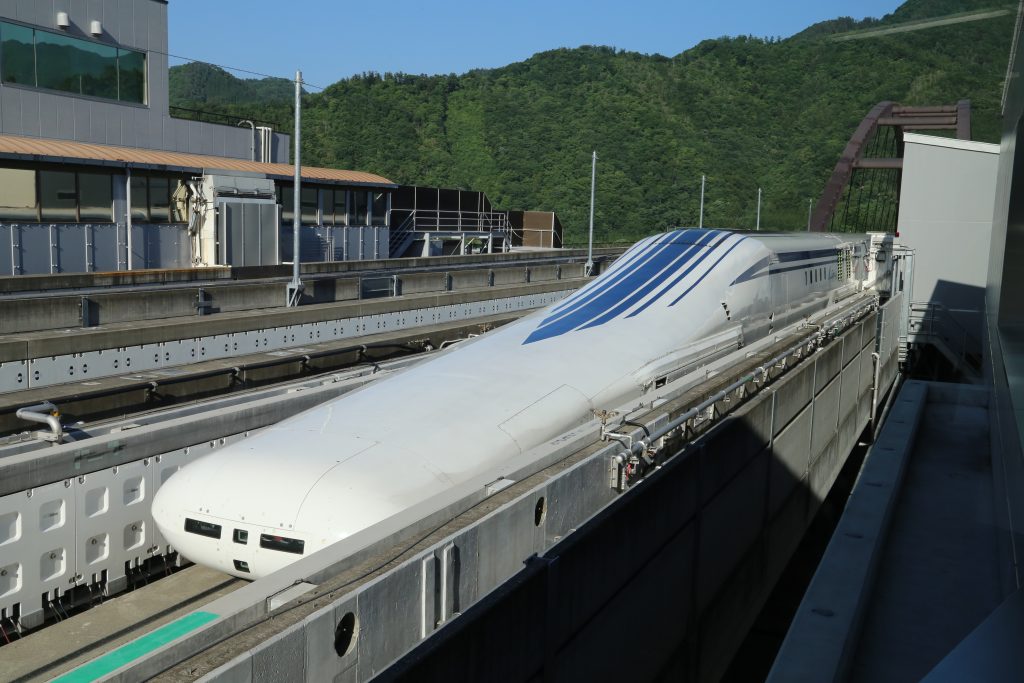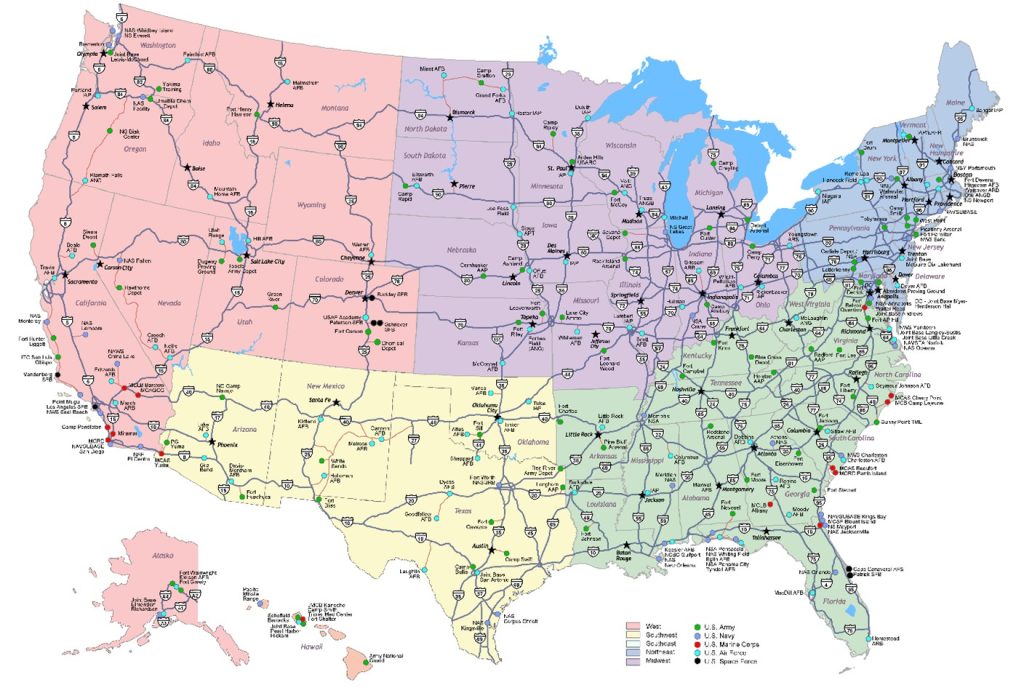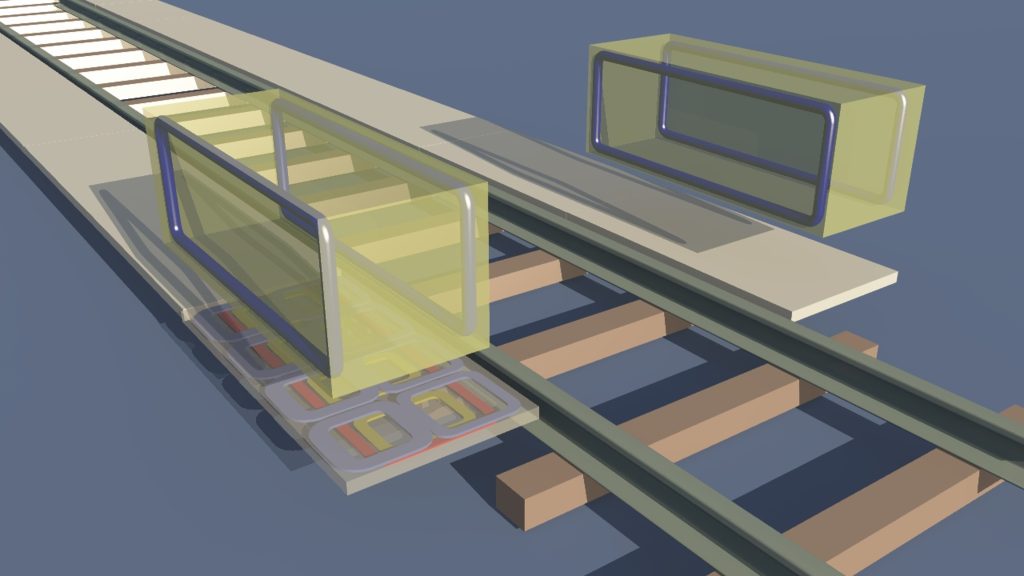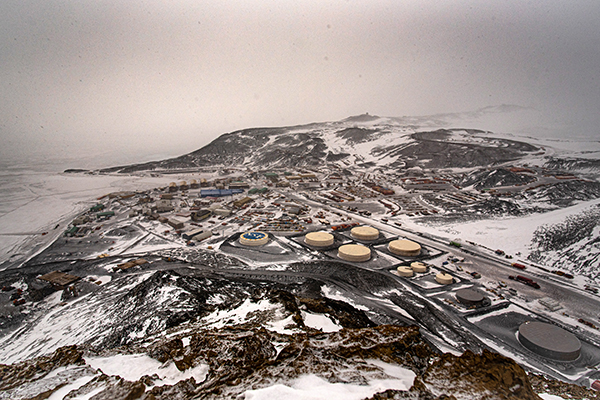By Robert Coullahan, CEM, CPP, M.SAME, Lt. Col. Frank Genadio, USAF (Ret.), Marc Bracken, and Cdr. James Jordan, SC, USN (Ret.)
A transportation network leveraging superconducting magnetic levitation technologies would bring benefits for logistics, surface transportation, and energy storage, as well as strengthen national defense priorities and the defense industrial base.

The United States has long been a world leader in transportation. In the 1800s, America developed canals like the Erie, invented the steamboat, and built the transcontinental railroad. In the 20th century, advancements like Henry Ford’s automobile, the Wright Brothers’ airplane, the Panama Canal, jet airliners, Eisenhower’s 45,000-mi interstate highway system, and our space program led the way.
However, many existing modes of transportation have reached their practical, cost-effective limits. Railroads have changed little in over a century. Highways are increasingly costly to maintain, in addition to being congested and unsafe in metropolitan areas. Even nautically, ports need frequent dredging and locks and dams require annual operations and maintenance to remain safe and functional for growing demand.
Superconducting magnetic levitation technologies are being leveraged by America’s adversaries and near-peer competitors for logistics, surface transportation, and grid-scale energy storage. While this technology was first introduced by two American scientists in the 1960s, it has largely been ignored domestically.
The creation of a nationally funded defense maglev network would support the country’s homeland security and defense requirements with a continent-wide advanced logistics infrastructure.
Understanding the Need

The genesis of the interstate highway system famously has its roots in the 1919 U.S. Army expedition of trucks and tanks across the continental United States (Dwight Eisenhower was a young lieutenant colonel at the time, traveling with the convoy). Over those 62 days, the soldiers traveled 3,200-mi over roads described by Eisenhower as a “succession of dust, ruts, pits, and holes.” Later, as president, he drew from this experience to champion the passage of the Federal Aid Highway Act of 1956 (also, National Interstate & Defense Highways Act). In addition to the public transportation benefits that a highway system would bring, the investment would provide defense benefits. The inclusion of the defense aspects would aid in overcoming opposition in Congress to the cost of modernizing the nation’s road infrastructure and helped justify the legislation’s passage.
In a similar manner, a defense maglev network and its superconducting magnetic levitation technologies would open new supply chains and further developments in manufacturing and engineering that strengthen the defense industrial base. Some of the innovative technologies and other developments that would be required in the construction of such a network include quadrupole magnet assemblies leveraging high temperature superconducting and cryocooler technologies; superconducting wire and cable materials; roll-on/roll-off freight vehicles; and prefabricated guideway components and polymer concrete panels for rapid construction.
The network would also boost defense capabilities through a number of nationwide benefits.
- Rapid mobilization of troops and equipment to an internal “flash point” at eight times the current speed.
- Much faster supply container movement to and from sea, air, and land ports in an all-weather resilient infrastructure.
- Expedited distribution of materiel from Defense Logistics Agency depots, with military command and control exercised by the U.S. Transportation Command.
- Implementation of a Medical Response Disaster Train for large-scale patient evacuation away from mass casualty incidents to higher levels of care.
Power and Precision
Development of superconducting magnetic levitation and a transportation network built around it would make nationwide advancements to meeting critical readiness needs.
Maglev vehicles travel along an elevated guideway with no physical contact at clearances of several inches. The vehicles are magnetically propelled by the interaction of their integral superconducting magnets with the alternating current that energizes a sequence of aluminum loops mounted on the guideway. Vehicle speed is controlled by the frequency of the current in the propulsion loops. To maintain constant speed, the alternating current frequency is held constant. To decelerate, frequency is decreased. Maglev vehicles are locked into position by a traveling alternating current wave.
Superconducting magnetic levitation architecture contains several key features that provide it with advantages over traditional rail or highway systems.
- Maglev eliminates rolling friction and is more energy efficient than steel-wheeled transport.
- Superconducting magnets eliminate electrical resistance and are more powerful than conventional electromagnets, permitting scale-up to heavy freight loads (conventional electromagnets of equivalent strength to superconducting magnets would melt magnets).
- Less moving parts means minimal operations and maintenance costs.
- The cost of high temperature superconducting has dropped significantly and the potential of cryocoolers promises less complicated components.
- Low-cost prefabricated narrow beam guideways facilitate rapid onsite construction.
- Electronic switching enables maglev vehicles to switch off the main line at high speeds, permitting greater route speed and flexible station spacing.
- Ability to adapt conventional rail systems to a maglev system using maglev emplacement on railroad infrastructure.
- Powerful quadrupole magnets enable lifting the heaviest loads with magnetic fringe fields that do not exceed the ambient Earth fields.
Efforts to Reconsider
Superconducting Maglev was invented in 1966 by Gordon Danby, Ph.D. and James Powell, Sc.D. at Brookhaven National Laboratory. Learning of their inventions, scientists and engineers from Japan and other countries visited them to obtain details. Other governments implemented Maglev systems, and these are now operational in China, South Korea, and Japan. The U.S. did virtually nothing.
The Federal Railroad Administration funded early technology demonstrations by the Danby-Powell team. Subsequent self-funded projects implemented prototype magnet systems for propulsion, lift, and control. There was select appetite for congressional funding to invest in research, development, test and evaluation, but a proposed bill failed. Without additional funding, momentum, for the most part, stalled.
More recently, the Federal Railroad Administration has shown modest interest again, electing to fund Northeast Maglev for design and development of a pilot maglev link between Baltimore and Washington, D.C. The funding, issued in 2016, supports preparatory requirements related to Environmental Impact Statements and the National Environmental Policy Act. Northeast Maglev proposes a system using Japanese maglev products based on an alliance with Central Japan Railway Company and contractor Louis Berger, both funded to address performance specifications. This could, however, facilitate adoption of a Japanese guideway standard.1
Magnet Configuration. The second generation U.S. superconducting magnetic levitation employs a quadrupole magnet configuration. This substantially enhances vehicle propulsion, vertical lift and stability, horizontal stability, and positioning. It also reduces both fringe fields and the weight of magnetic shielding. The quadrupole design enables heavier freight lift capacity and high-speed electronic switching (as well as the low-cost adaptation of conventional railroad trackage).
A maglev emplacement on railroad infrastructure adaptation enables a transition from conventional rail to maglev—leveraging existing rail infrastructure, bridges, tunnels, rail yards, maritime and inland ports, and rail rights-of-way.
Rail is limited in handling steep grades because the locomotives will just spin in place. Conversely, powerful quadrupole magnets permit operation on steeper ascending grade than traditional railroads (limited to about 4 percent or less), which reduces the need for tunnels or terrain sculpting.
Guideway Design. The evolution of guideway design is an important consideration in the adoption of a national maglev standard, just as rail gauge was critical to enabling a unified transcontinental railway. Compare three guideway designs: the first generation Japan Railways SCM U-Track, a cumbersome and costly trough design; the U.S. second generation Maglev 2000 Monorail configuration with minimal construction and optimal pre-fabrication; and the maglev emplacement on railroad infrastructure-adapted rail configuration, which offers true intermodal transition to maglev service.
The aluminum loop guideway panel provides vertical lift and stability, lateral stability, and linear synchronous propulsion. It has three sets of multi-turn aluminum loops. What are four short dipole loops on each side of the beam are connected into a null flux circuit that maintains the vehicle in a centered position on the beam. When centered, no current flows in the aluminum null flux circuit. If an external force such as wind acts to push the vehicles away from its centered position, a restorative magnetic force develops that opposes the external force.
The long dipole loop is part of the Linear Synchronous Motor propulsion system, in which the loops on a sequence of panels are connected in series to form an energized block along which the vehicle travels. As the vehicle leaves an energized block, its alternating current propulsion current is switched into the next block that the vehicle enters.
The four figure-eight loops provide lateral stability; they generate magnetic restoring forces if an external force acts to displace the vehicle from its centered position on the guideway. The dipole loops act individually, with inductive currents to levitate and vertically stabilize the vehicle as it passes overhead.
Call to Action
Early analysis of the requirements for a defense maglev network indicates that a breadth of engineering disciplines will be essential. A documented body of knowledge, intellectual property, and trade secrets accrued over the course of six decades of design, engineering, and computational analysis provide the seeds.
Investing to augment logistics systems on the downward arc of sustainment is essential. A next step would be the establishment of an Office for Superconducting Maglev Technologies within the Department of Defense to coordinate development and interagency mission interests (energy, commerce, transportation, homeland security, and military). A national maglev test and certification program should be established to build the digital twin of the network.

In terms of funding, a maglev network offers opportunities for cost recovery, including fee-based usage payments to the Highway Trust Fund, Amtrak, and private railroads for use of the rights-of-way. Supplemental cost recovery could include a resilient, shielded power distribution network for electric vehicle charging stations and geographically expanded broadband access. Elevated guideways offer a resilient service conduit for power and communications distribution.
Further developing superconducting magnetic levitation technology would have benefits beyond maglev as well: these range from the practical lifesaving technology fielded in the form of magnetic resonance imaging systems to the experimental research at the European Organization for Nuclear Research Large Hadron Collider. A focused applied research and integration advocate in government would enable even greater advancements.
Ignoring key technologies such as superconducting maglev underscores the growing deficit in America’s logistics and technology preeminence and the gulf between our applied research and that of our competitors (adversaries are implementing these systems in plain view today). It is noteworthy that applied research in superconducting magnetic levitation for logistics would also enable breakthroughs for its future use in grid-scale energy storage and in extremely low-cost electromagnetic space launch infrastructure.
Federal Report on Maglev
A report issued in 1993 by the Department of Transportation, Department of Energy, and U.S. Army Corps of Engineers (Final Report on the National Maglev Initiative) identified, based on an extensive multi-year study, the potential of maglev viability in the United States. Their conclusion is that it was feasible, and would be an advantageous initiative to pursue, but would need large federal investment in order to achieve.
While the study reviewed primarily conventional maglev designs such as the Halbach Arrays, using attractive forces, not the more resilient, high-operational availability repelling designs available today, it still expresses the historic interest given to the technologies.
Since the report is over 30 years old, it preceded much of the architectural enhancements made available by superconducting maglev. Yet the recommendations still hold great relevance, including the need for an initial federal investment in research and development to engender the approved guideway and control systems designs, performance, and operational concepts that would lead to published standards. Today, federal partners could do much using the best practices of digital twins and model-based systems engineering to create, model, test and evaluate the best options for a national network.
International investment bankers have told U.S. patentholders that they wait only for the government to adopt and promulgate technology standards, and the investments will follow. Government program managers ask why the private sector has not invested in superconducting magnetic levitation and brought it to market. The standoff persists.
There has been unbridled access to government funding and the establishment of offices overseeing the race to develop artificial intelligence and quantum computing. Still other technologies languish, despite the body of knowledge on which they stand.
Needs for the Future
Our nation faces grand challenges in modernizing its critical infrastructure. Not considering the benefits of superconducting magnetic levitation runs the risk of hobbling the U.S. economy for decades to come.
The National Defense Industrial Strategy, released in December 2023, sounds an alarm on the readiness of the defense industrial base to respond to modern conflict at the velocity, scale, and flexibility necessary to meet the dynamic requirements of a major modern conflict. Development of superconducting magnetic levitation and a transportation network built around it would make nationwide advancements to meeting critical readiness needs. The antecedents of leveraging technology developed for the military to support everyday public use abound. Investing in maglev would have both near-term and long-term utilization for the United States.
Robert Coullahan, CEM, CPP, M.SAME, is President, Readiness Resource Group Inc.; coullahan@readinessresource.net.
Lt. Col. Frank Genadio, USAF (Ret.), is Advisor; genadiof001@hawaii.rr.com.
Marc Bracken is Systems Engineer & Senior Principal, C4DB; marcbracken@c4db.com.
Cdr. James Jordan, SC, USN (Ret.), is Retired Senior Policy Advisor, U.S. Senate; james.jordan@cox.net.
1 The Japanese guideway standard is a design that the authors believe is inferior to the second-generation SCM simple monorail guideway.
More News from TME
-

A New Horizon for Scientific Research
The Antarctic Infrastructure Modernization for Science Project, currently underway in arguably the most remote and extreme environment on Earth, is modernizing research facilities at McMurdo Station to promote resiliency, improve sustainability, and increase energy efficiency. -

Boosting Installation Energy Resilience Through Geothermal Power
The Air Force Office of Energy Assurance is advancing two prototyping projects for geothermal energy, with the goal to both support clean energy generation goals and increase installation resilience. -

SAME DC & Baltimore – Sun. May 18 – Tour the N.S. Savannah (Free Event!)
Join the SAME DC & Baltimore Posts as we celebrate National Maritime Day 2025 with the N.S. Savannah Association for an open house tour of the N.S. Savannah on Sunday, May 18 from 10 am – 4 pm (Meet up at 1:30 pm). This event is free and open to the public. No RSVP is […]